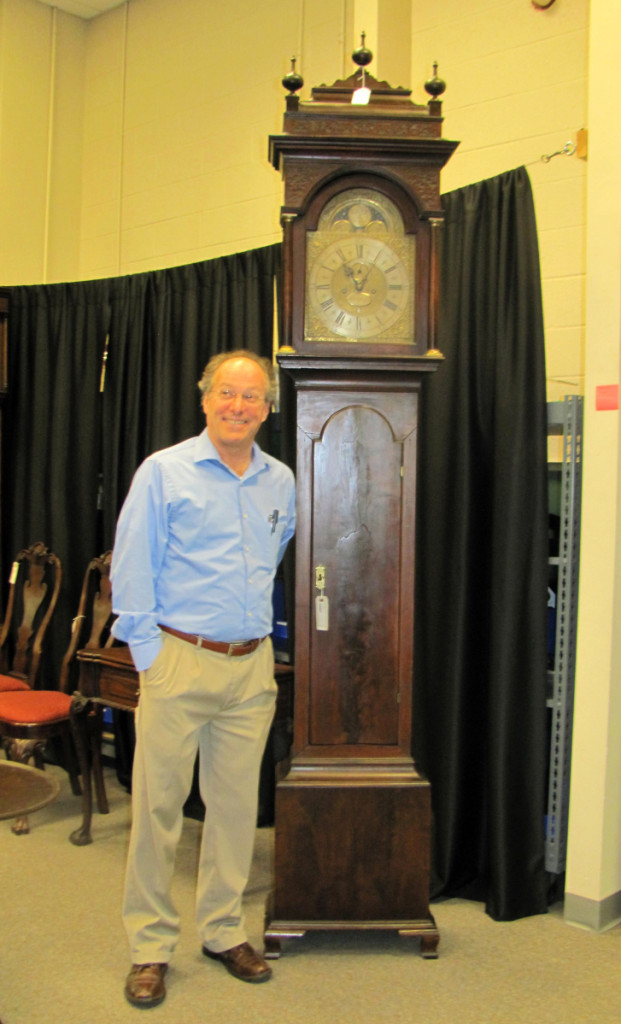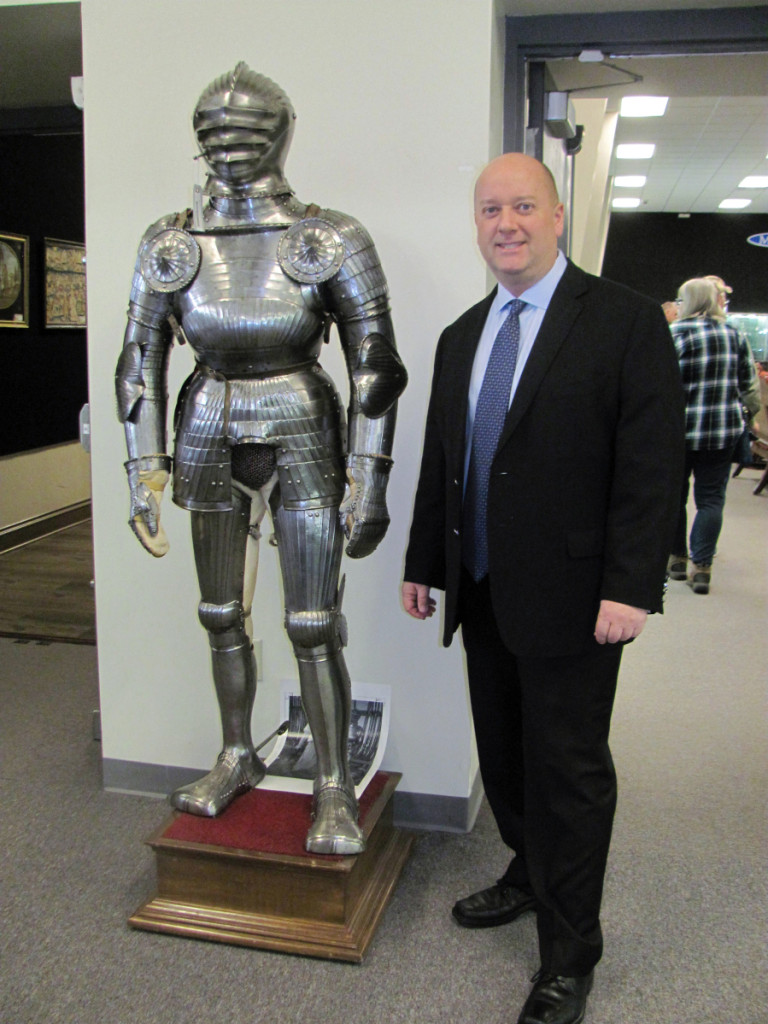
Before the sale, auctioneer Dan Morphy posed next to what he anticipated would be the top lot in the sale, and it was, bringing $270,600 ($75/150,000).
Review and Onsite Photos by Madelia Hickman Ring, Catalog Photos Courtesy Morphy Auctions
DENVER, PENN. – A single-owner collection of American furniture, guns and powder horns and decorative arts representing material culture from the Susquehanna Valley crossed the block at Morphy Auctions on Thursday, January 16. Assembled over more than 40 years by an anonymous collector who has decided it is “time for others to enjoy the collection,” the 220-lot sale totaled $2.3 million, saw strong prices across the board and was 98.6 percent sold when the gavel fell on the final lot.
The breakdown of the sale saw bidding in the room taking home 40 percent of the sale, with 23 percent selling to phone bidders and 21 percent to buyers using Morphy’s dedicated platform – Morphy Live – to bid online. The remaining 16 percent of lots sold to buyers bidding online through the three other online platforms that featured the sale.
The house acknowledged that the furniture aspect of the collection brought new bidders to Morphy and while it did not specify which lots were successfully acquired by institutions, confirmed that museums were among the successful buyers.
After the sale, Dan Morphy said, “I was very pleased with the result of this auction. We excel at this category of Americana and our buyer’s love to attend the live auction. We’ve handled many single consignor auctions to date in this category of collecting.” When asked if the collector was pleased, he said, “very pleased. The market is not what it used to be but considering the current state of the market, the prices were very good.”
Morphy is a leading name in gun auctions and the house emptied both barrels into promoting the sale, which featured suits of armor, long guns, pistols, powder horns and other related objects. “We received the collection back in July, so we had plenty of time to market the auction to its fullest potential. We developed a dedicated marketing strategy for this auction that included but was not limited to the local and national antiques publications, gun focused collector publications, social media and more.”
With regard to the present market for French and Indian War and Revolutionary War items, Morphy’s arms and armor specialist, David Geiger said, “I have recently seen momentum in the market for Eighteenth Century items, especially relating to the French and Indian War and the Revolutionary War. Interest is strong and many good items are bringing world record prices. In the Susquehanna sale, we sold the French and Indian War engraved Havana map powder horn for $50,430. I expect to see this market continue to be strong, due to the importance of this period in American history.”
Nine of the top ten prices achieved were arms and armor, led by a full-size composite Maximilian suit of armor, circa 1510-20, assembled by Bashford Dean in the early 1920s using elements from various provenances, including Prince Carl of Prussia and the Princes Radziwell, Nieswiez Castle, Lithuania and related to an example in the Metropolitan Museum of Art. The suit had been in the collection of Bashford Dean, who was the first president of the Arms & Armor Society and the first curator of Arms & Armor at the Metropolitan Museum. Competition for the suit came from all directions and in the end, it nearly doubled its high estimate ($75/150,000) when it sold for $270,600 to trade dealers in the room bidding on behalf of a client.
Pistol lots were considerably outmatched by lots of long guns, but a pair of American Revolutionary War flintlock pistols made in 1775 for Robert Roberts achieved $110,700, the third highest price in the sale. The pistols, which had been estimated at $50/100,000, were once owned by R.H. Coleman, the president of the Remington Arms Company, Inc. While Coleman owned them, the pistols were featured on the cover of the July 1972 issue of The American Rifleman, which included an article about them. A copy of the magazine and various receipts related to the provenance of the guns accompanied the lot, which was purchased by a buyer bidding on the phone with Geiger.
Another pair of Revolutionary War-era pistols made by John Sweitzer with silver mounts nailed the midpoint of the estimate ($50/100,000) when the pair sold for $79,950 to a bidder on the phone with Kelly Kinzle. The pair had been illustrated extensively and their provenance included John S. duMont and Joe Kindig Jr.
Leading a selection of nearly 50 long guns was a diminutive relief-carved flintlock Kentucky rifle made and signed by Jacob Welshans. Before he opened bidding on the lot, Morphy said it was in “completely untouched” condition and had provenance to the Welshans family. Morphy had so much presale interest that he could open bidding at $27,500, just shy of its $30/60,000 estimate; a bidder in the room prevailed, taking it home for $67,650.
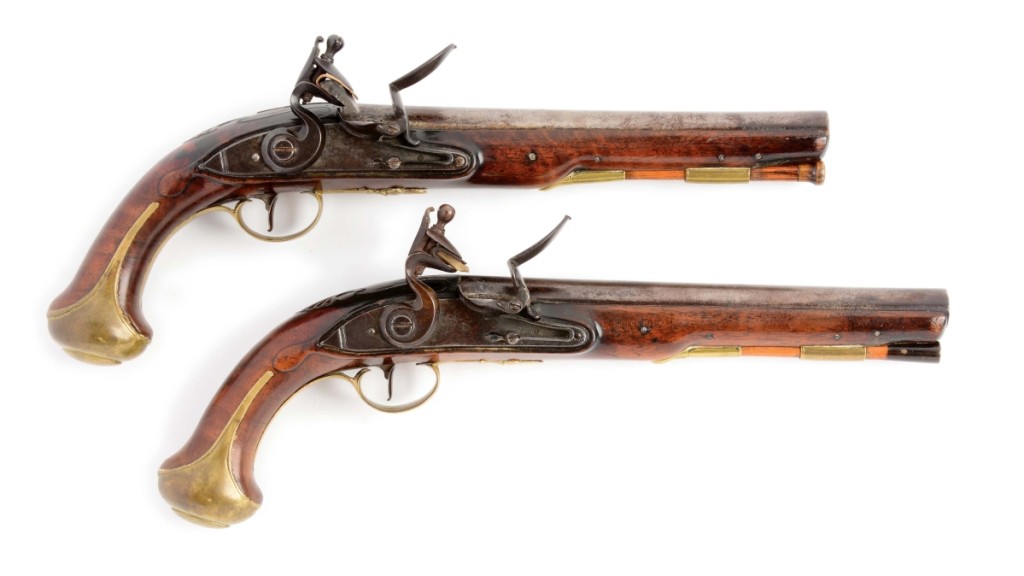
A bidder on the phone with David Geiger won this pair of Revolutionary War flintlock pistols made for Robert Roberts for $110,700 ($50/100,000).
Jacob Kuntz was referred to by Joe Kindig III as “in a class by himself,” and the sale featured six guns – two pistols and four long guns – attributed to the Eighteenth Century gunmaker. Of these, the highest price achieved for a rifle was $61,500 for a flintlock Kentucky rifle with the Pennsylvania state seal engraved on its brass patchbox that was estimated at $40/60,000. With related examples in the Metropolitan Museum of Art, the Philadelphia Museum of Art and Winterthur Museum, Garden and Library, it is not surprising that the gun generated so much interest.
The highest price paid for a Kuntz pistol was $23,370 with an estimate of $15/30,000 that an online bidder won against bidders on the phone and in the room. Once the last of the Kuntz-made guns had crossed the block, an anonymous gentleman who had been attending the sale approached this reporter to say Kuntz had been his great-great-great-great-grandfather. He disclosed that he owned “just an ordinary everyday gun” Kuntz had made and had attended the sale to “see what people would pay for his better guns.” When asked if he got anything at the sale, the gentleman smiled, shook his head and said, “just the catalog.”
Of the seven powder horn lots in the sale, the one that brought the most was an example engraved with a map of Havana and dated 1763 that Morphy called “magnificent.” According to the catalog, the horn is one of only “a handful” known to exist. The horn had been illustrated in Nathan L. Swayze’s Engraved Powder Horns of the French & Indian War and the Revolutionary War Era, and had been in Swayze’s collection, with additional provenance to Joe Kindig Antiques and William H. Guthman. Estimated at $30/60,000, it saw competition from bidders in the room and online before David Geiger’s client on the phone won it for $50,430.
The two pipe tomahawks in the collection were offered consecutively, with the better of the two crossing the block first. The first featured a tiger maple haft but, more importantly, a brass head stamped “J. Welshans” and believed to be the only known example by Jacob Welshans and one of the only known examples signed by a Pennsylvania gunsmith. Its $8/15,000 estimate generated considerable interest and it sold to an online bidder for $15,990. The second example was an unattributed example but also exceeded its $2/4,000 estimate, selling for $5,228 to a bidder in the room.
The sale was the inaugural sale for specialist/dealer Kelly Kinzle, who has brought his expertise with American furniture, folk art and decorative arts to Morphy. After the sale, Kinzle, who was busy getting ready to exhibit at the Winter Show in New York City the following week, said, “I think it went well. I thought some things were good buys and others brought premium prices.”
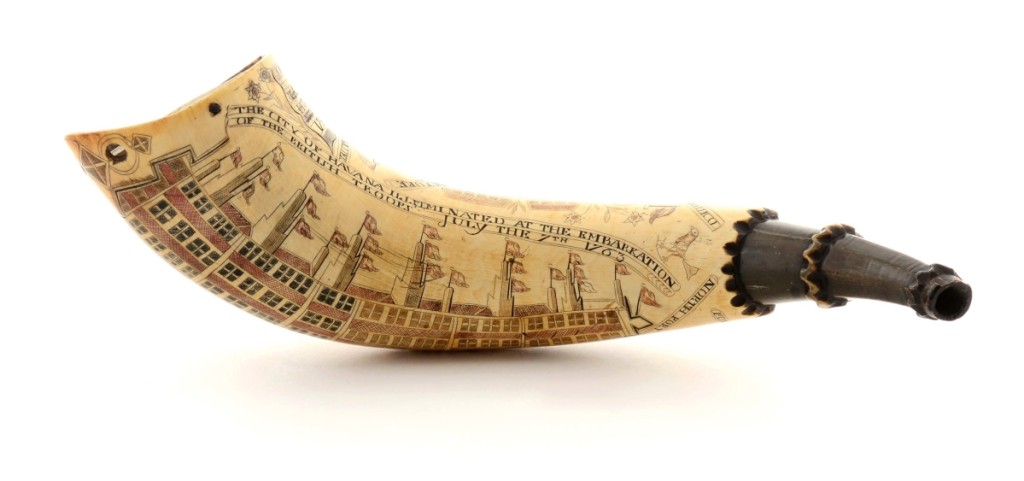
David Geiger’s phone bidder took this powder horn, engraved with a map of Havana, Cuba, to $50,430 ($30/60,000).
The offerings of American furniture, folk art and decorative arts comprised nearly two-thirds of the sale, with a circa 1740 walnut tall case clock by Philadelphia clockmaker, Peter Stretch, selling for $166,050, the second highest price in the sale. According to the catalog, the ogee feet on the clock appeared to be original, giving the clock the distinction of being the earliest clock with ogee feet. Bearing provenance to H.L. Chalfant and an estimate of $50/80,000, the clock garnered considerable interest and finally sold to a phone bidder, underbid by a bidder in the room. Morphy elicited chuckles when he announced to the room that the selling price included Kinzle coming to the buyer’s house to install the clock.
A neoclassical brass and ormolu mounted mantel clock depicting George Washington, the enameled white dial inscribed “Dubuc Rue Michel-Le-Conte No. 33 A Paris,” also did well, bringing $43,050 from a phone bidder, well within its $40/80,000 estimate. The third and last clock in the sale – a mahogany tall case clock with brass and moon-phases dial engraved “John Wood Philadelphia.” Estimated at $20/30,000, it sold to a buyer in the room for $15,600.
A trade buyer in the room snapped up a Philadelphia Chippendale turret-corner games table for $31,980, while $27,000 was enough for an online bidder to prevail on a New York or Philadelphia camel-back sofa that had been offered at Sotheby’s in 2006.
Three lots of furniture made by New Hope, Penn., modern design master, George Nakashima, demonstrated the breadth of the collector’s vision and were offered early in the sale. A “Frenchman’s Cove II” dining table brought $24,320 ($20/40,000); a set of four side chairs closed at $7,680 ($10/20,000), the same price realized by a pair of armchairs ($10/20,000). All of the bidding action on the Nakashima lots took place online, with three different bidders prevailing.
Some of the lots that Kinzle may have been referring to as “good buys” were a pair of Chippendale mahogany armchairs, possibly from Maryland, that brought $18,000 from an online bidder ($30/60,000); a Philadelphia Queen Anne mahogany dressing table that sold to another online bidder for $10,080 ($30/50,000) and a miniature Lancaster County sulfur inlaid chest that a phone bidder snapped up for $16,800 ($25/35,000).
The sale catalog thanked Lisa Minardi, executive director of Historic Trappe and the Center for Pennsylvania German Studies, for her assistance in cataloging the fraktur in the collection, which offered approximately a dozen lots. Leading the fraktur lots was a drawing of an alligator and two mermaids and attributed to Jacob Otto, circa 1800-20 and possibly of Lancaster County, Penn. Estimated at $10/20,000, it brought $19,200 from an online bidder.
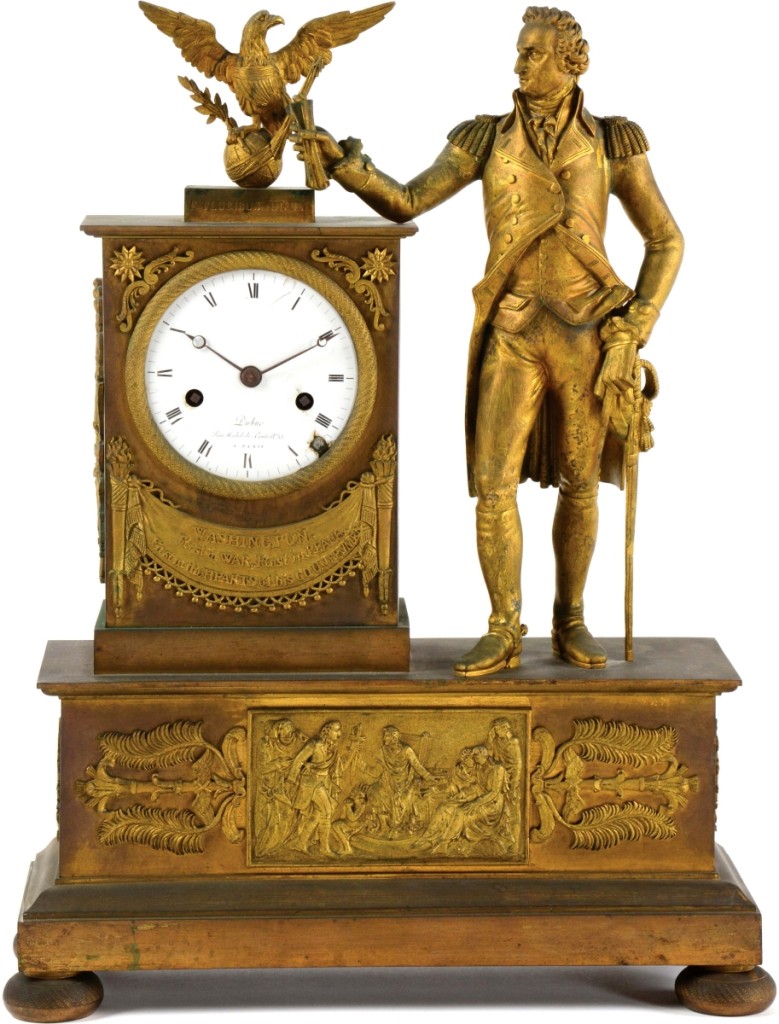
This brass and ormolu “George Washington” mantel clock made by Dubuc went to a photo bidder for $43,050 ($40/80,000).
Other notable fraktur lots in the sale included a birth and baptismal certificate for Peter Hana signed by Daniel Peterman (1797-1871), York County, Penn., circa 1823 that an online bidder pushed past its high estimate to finish at $5,535 and a birth and baptismal certificate for Scharlotta Deibler attributed to Johann Friederich Mencke of Dauphin County, Penn., that yet another online bidder acquired for $2,091, more than twice its high estimate.
More than 20 lots of paintings – oils on canvas, watercolor pictures, miniature portraits, and silhouettes – were on offer, with works by Jacob Eicholtz being most prominent. When Eicholtz’s portrait of Mrs John Bannister Gibson came up, Morphy announced it to be “one of the nicest Jacob Eicholtz portraits to ever be offered at public sale.” While it was not fresh to the market, having been offered in 1993 at Christie’s and at Sotheby’s in 2015 (where it sold for $13,750), there was sufficient interest in the painting for it to improve over its most recent public offering, bringing $19,200 from a bidder on the phone with Morphy Auctions’ chief financial officer, Dana Costello.
Other notable fine arts lots included an American School portrait of George Washington after John Trumbull’s portrait of Washington at Dorchester Heights that finished at $14,145 ($4/8,000); a set of four American school watercolor pictures of the Four Seasons that were in period frames and backed with early Nineteenth Century newspapers from Carlisle, Penn., which were a good buy, selling on the opening bid for $6,150 ($10/20,000) and an unusual lot of three late Nineteenth Century miniature paintings rendered on what were cataloged as animal ears, that sold to an online buyer for $185 against a $100/500 estimate.
Other decorative arts categories were modestly represented. The needlework and textile offerings were limited but most saw sufficient interest to sell within or above estimate, with the strongest result achieved by a Charles II silkwork picture that a phone bidder bought for $5,535 ($3/5,000). Of nearly a dozen ceramic lots, the highest price was $3,600 that a buyer in the room paid for a lot of three Tucker porcelain pitchers ($1,50/3,000), while a large Bristol posset pot with blue and white decoration achieved $3,383 from a phone bidder, more than twice its low estimate. Topping offerings of silver was a two-piece lot comprising a teapot and cream pitcher by Lancaster, Penn., silversmith, Lewis Heck, that Geiger’s phone bidder took to $11,070 ($4,5/7,500). The same phone bidder took home two cream pitchers by John Ewing for $3,075 ($1/2,000) and a beaker by William Haverstick for $984 ($750-$1,500).
Morphy paused during the sale to announce an upcoming May sale and partnership with James Kochan. After the sale, Morphy confirmed this, saying further, “In response to the strong market for early items, we will be having a specialty sale in May, just prior to our extraordinary firearms sale. This sale will focus on early arms, militaria, art and documents from the French and Indian War period through the War of 1812. We are pleased to announce that James Kochan has recently joined our team and he will be working closely with me to assemble a fine offering for the May sale. My specialty is arms, while Jim specializes in uniforms, documents, Americana and art. This combination will allow us to have a comprehensive sale of fresh-to-the-market items dating to that time period.”
All prices quoted include buyer’s premium as reported by the auction house. For additional information, 877-968-8880 or www.morphyauctions.com.

